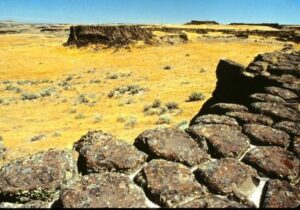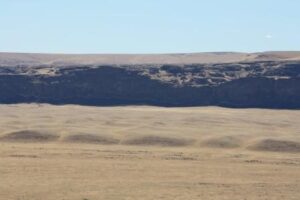NPS Photo
The following images depict some Basic Geologic Terms you might encounter along throughout Ice Age Floods National Geologic Trail.
For a more comprehensive list check our Glossary of Technical Terms.
 BASALT
BASALT
A dark igneous volcanic rock composed of primarily two minerals: plagioclase and pyroxene. Over a period of 11 million years (17 to 6 million years B.P.) hundreds of flows of Columbia River basalt were extruded from long, linear vents in southeastern Washington, northeastern Oregon and west-central Idaho and traveled for hundreds of miles before cooling and solidifying to form the Columbia Plateau.
NPS Photo
 CHANNELED SCABLAND
CHANNELED SCABLAND
An eroded, interconnected network of streamlined loess islands, flood channels, coulees, cataracts, and plunge pools scoured into basalt by cataclysmic floods in eastern Washington State. These features are unique to this region of the Earth, however they are similar to channel networks observed on Mars.
NPS Photo
 GIANT CURRENT RIPPLES – GCRs
GIANT CURRENT RIPPLES – GCRs
Extremely large waveforms created by the transport and deposition of coarse-grained* flood material during Ice Age floods. They develop at right angles to the direction of flow, much the same as the smaller ripples we see along modern beaches and river bottoms. GCR’s, composed of coarse-grained sand and gravel, have wavelengths of 100-400 ft and amplitudes of 3-25 ft (Baker 1978). NPS Photo
This glossary was prepared by the Ice Age Floods Institute to help people of all backgrounds understand geologic terminology.
NOTE: Terms marked with an asterisk (*) are defined elsewhere in the glossary.
Pause on an entry for a short description pop-up